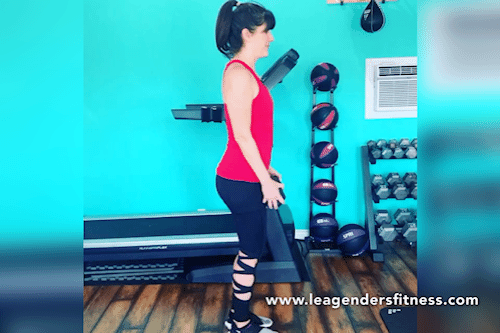Welcome to the latest edition of workout Wednesday; when each week, I share a new running or strength training for runners workout. This week we are focusing on the single-leg deadlift, and some fun variations, because it is one of the most effective exercises a runner can do to see improvements in running performance and injury prevention.
One of the essential skills that a runner can learn is balance. Why? Because you repeatedly balance on one leg at a time for the duration of your run. A runner with poor balance skills is a disaster waiting to happen, especially as you add volume to your training. Poor balance can lead to muscle compensations that may lead to an injury.
The good news is that balance is a skill. If you practice it, you will improve, and progressions in balance skills will translate to stronger running performance.
It serves runners well to develop independent hip and leg strength. Single-leg exercises will help you run stronger as you balance your weight on one leg at a time.
Single-leg exercises help avoid muscle imbalances that can occur from one side to the other. If muscles on one leg are stronger than the other, you can't address these imbalances with two leg exercises, which is why it is important to train both bi-laterally (like squats and deadlifts) and uni-laterally (like lunges and single-leg deadlifts). My favorite single-leg exercise for runners is a single-leg deadlift.
HOW TO PERFORM A SINGLE LEG DEADLIFT
Keep the knee on your standing leg slightly bent. Don't lock out your knee.
Hinge at the hips, keep your back straight. Don't bend, hinge.
Don't allow your standing knee to cave in towards the center; think about keeping your knee lined up over your middle toe.
Keep your back leg toes pointing down; this helps your hips to stay square to the ground.
Try to prevent your body from rotating. The anti-rotation helps build core strength.
Perform the reps in a slow controlled manner. Don't rush it as you hinge or return to standing. Faster reps may be less effective as you rely on momentum and not muscles to perform the reps.
If you lose balance in the middle of a rep, consider it a "no-rep" and repeat it.
SINGLE-LEG DEADLIFT EXERCISE VARIATIONS
Keep in mind that our bodies adapt to the stresses we place upon it, which means if we keep doing the same exercises over and over, then they become less effective over time. We have to always think about how we can progress a workout, to keep it challenging, so that our bodies continue to respond. A few ways to advance an exercise are:
Increase reps
Increase sets
Increase weights or intensity
Increase the difficulty of the exercise
Decrease rest periods
Don't attempt to increase these variables all at once, but raising one a time, slowly over time, will bring continuous results.
Here are the variations of the single-leg deadlift so that you can improve over time.
VERSION ONE SINGLE-LEG DEADLIFT: FOAM ROLLER ASSISTED
A long foam roller can help you keep proper form in the single-leg deadlift. Press the foam roller between your foot and your hand as you lower to help keep your hips squared to the ground, and your back foot pointed downward. Technically speaking, this is a single-leg balance exercise, not lifting anything, but it's the first step to take when learning the single-leg deadlift exercise. Don't rush progress. Start from where you are today.
VERSION TWO SINGLE-LEG DEADLIFT: BODY WEIGHT
Practice form with your bodyweight before adding weight. Practice makes progression. Do these single-leg toe touches often. They are not intense, so a few reps and sets every day may be appropriate for most runners to develop the skill. If you are wobbly, keep practicing. Try this exercise standing parallel to a wall for a bit of extra support if you need it.
VERSION THREE SINGLE-LEG DEADLIFT: SINGLE DUMBBELL
Grip a single dumbbell (or medicine ball) with both hands on each end, and hinge at the hips with a straight back. Increase the weight as you get stronger.
VERSION FOUR SINGLE-LEG DEADLIFT: KETTLEBELL SINGLE SIDE
Hold a kettlebell or dumbbell in the same hand as your support leg. Keep in mind all the same form cues. Don't allow your body to rotate. Progressively increase weight over time.
VERSION FIVE SINGLE-LEG DEADLIFT: KETTLEBELL OPPOSITE SIDE
Now try holding the kettlebell or dumbbell on the opposite side of the support leg. The focus here is a straight back and not to let the body rotate.
VERSION SIX SINGLE-LEG DEADLIFT: BAR WITH ROW
This time hold a bar or barbell. I am using a 30lb bar in this demonstration. Once you are in a low position, row the bar up towards your chest to increase your balance ability and to build back strength. You can also perform this exercise with a single dumbbell gripped with two hands on each end or, to make it harder a kettlebell in each hand.
The Single-Leg Deadlift Workout
If you are performing a weighted single-leg deadlift exercise, I suggest warming up with the foam roller version to groove the movement before adding weights. Try this:
8 reps on each leg with a foam roller for two sets
10 reps on each leg with a kettlebell for three sets
Trainer Tips
If your balance is not great (yet), then practice with body weight and the foam roller until you improve. Progress to the harder versions as you get stronger. Do sets of eight daily, and you'll improve quickly.
Continue to add weight as you get stronger.
Try one of these single-leg deadlift variations as part of your warm-up before your next run.
Single-leg deadlifts are one of the most effective exercises for runners! Get strong and run strong friends!
Let me know how it goes. If you try it out, let me know on Instagram by tagging me @leagendersfitness
Interested in more single-leg exercises? Check out these lunge variations to work your Glutes from every angle.
Did you like this post? Do you know someone who might benefit? It helps me when you share with your friends and followers on Facebook, Twitter, or Pinterest.
Questions? I’d love to help.


















Forget the pressure to "end the year strong." This December, I am exploring a different approach: ending the year soft. Learn how compassion, rest, and grace can set you up for a healthier New Year than pushing ever could.